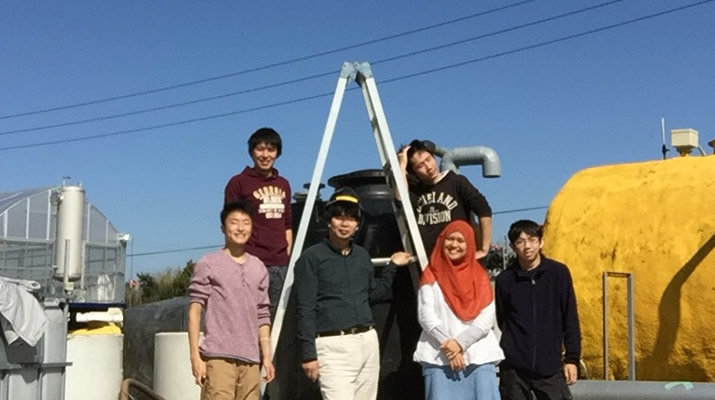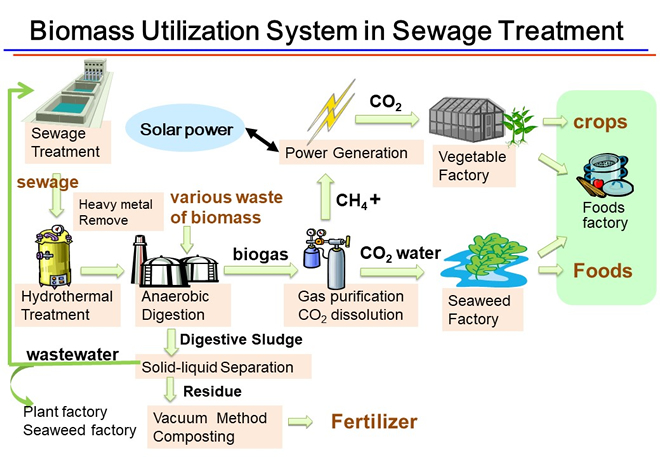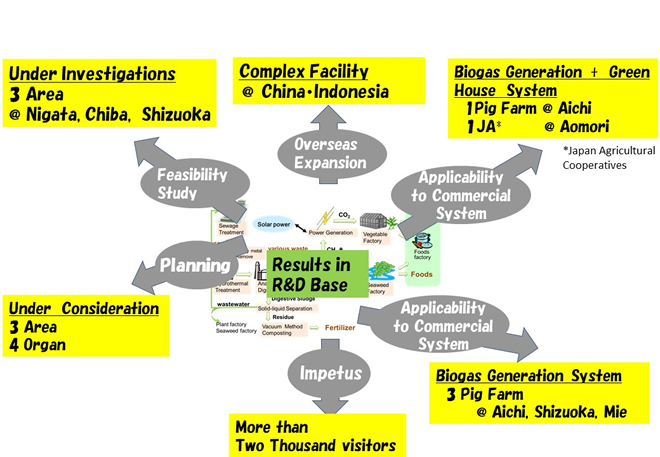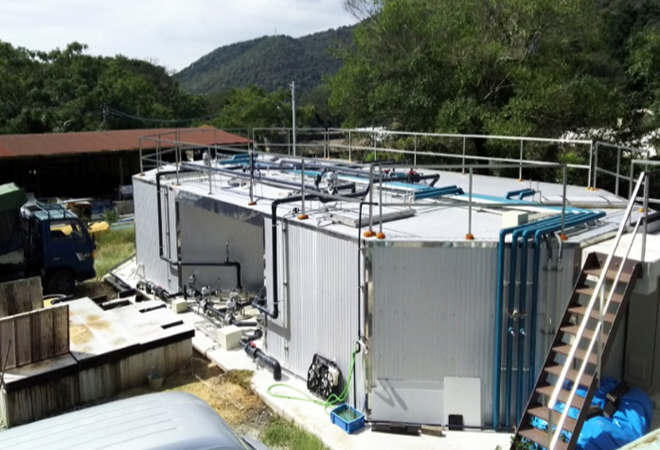
ここからコンテンツです。

Promoting a System That Effectively Utilizes Biomass from Organic Waste
Versatile composite system effectively uses biomass, residual heat, and waste CO2 By Yoichi Atsuta and Hiroyuki Daimon
We are in dire need of popularizing anaerobic digestion technology (methane fermentation) that effectively utilizes biomass containing a large amount of water from renewable resources such as livestock waste and organic waste. For the last five years, our research group has tried to convince society through experiments showcasing the efficacy of composite systems that not only generate power using biogas, which is a by-product of anaerobic digestion, but also effectively utilize the digestive juices, residual heat, and waste gas (carbon dioxide) that are generated during this process, and even produce manure and crops. As a result, alongside the private corporations we have collaborated with we have succeeded in developing equipment which can be expected to achieve the implementation of anaerobic digestion technology as the core of this system at a lower price than conventional equipment. This will hopefully lead to our technology being used at domestic small-to-medium-sized pig farms, and boost its integration into society.
The introduction of the feed-in-tariff law for electric power greatly increased the amount of power being generated by renewable resources such as solar power across Japan. However, Japan lags behind the rest of the world in terms of implementing technology for anaerobic digestion that effectively utilizes biomass with a high water content, such as that from livestock waste and organic waste, which are also renewable resources. In order to solve this issue, we came to the conclusion that it was necessary to focus on improving existing technologies to create a system for effectively utilizing biomass that provides greater benefits.

For the last five years, our research group has tried to convince society of the benefits of this system. We conducted experiments which showcased the efficacy of composite systems that not only generate power using biogas, which is a by-product of anaerobic digestion, but also effectively utilize the digestive juices, residual heat, and waste gas (carbon dioxide) that are generated during this process, and even produce manure and crops.
The system we developed from 2011 to 2015 with the help of a MEXT grant performed anaerobic digestion using sewage sludge and organic waste from homes and supermarkets as raw materials. The biogas generated in this process was then partially separated into methane and carbon dioxide using a gas-dissolving apparatus. A large amount of this carbon dioxide was dissolved in water, and this water was used to promote seaweed photosynthesis. The methane gas, which had increased in purity, was used as fuel to generate power. The waste carbon dioxide generated in this step was used as a photosynthesis accelerator, and residual heat was used for heating. With this, we managed to cultivate vegetables in a greenhouse. We are currently carrying out similar experiments based on collaborative research with private corporations.
Through these experiments, we were able to gain important knowledge on factors such as the materials and energy balance of the entirety of systems that combine element technologies with different properties. The element technologies forming our system do not always have to follow the process shown in Fig. 1, and may be freely changed depending on area characteristics and the state of the business using the system. Therefore, it is possible to carry out experiments hypothesizing as many different situations as possible and suggest a packaged system with various types of anaerobic digestion technologies suited to the respective area. We have already drawn up plans for domestic and foreign municipalities and organic waste disposal companies (Fig. 2).

When expanding the use of such a system, it is important to reduce equipment costs. Therefore, we are currently developing a versatile facility alongside the private corporations we collaborate with (Fig. 3) that utilizes our anaerobic digestion technology, which is the heart of our system. This facility boasts a very simple structure, and we have been able to achieve installation at small-to-medium-sized pig farms and food factories domestically.
Since it was first implemented (in 2016), it has been introduced at three small-to-medium-sized pig farms, and we are currently making plans for its implementation in many more places. The farms currently using this facility have been able to earn additional income by selling power from manure, as well as reduce odor problems and composting work, stabilize their water processing capability, and most importantly strengthen their presence as farmers. Our plant has also been recognized by England’s Anaerobic Digestion and Bioresources Association, winning their Best International Small-scale Plant Award in July 2017.

Project Associate Professor Yoichi Atsuta, who has been conducting experiments and forming plans for expanding this system into other areas, says, “I’m surprised at the demand for our biomass usage system. We would like people to know that they can convert their unused biomass into power and products such as vegetables, and improve the negative reputation waste products and manure have had.”
Professor Hiroyuki Daimon, Project Manager, believes that, “Effectively using biomass is usually achieved by forming alliances between various institutions in academia and industry. Universities actively playing a central role in the planning stage to organize information in an objective manner will improve the feasibility and sustainability of this business.”
Our system contributes to generating renewable energy and reusing regional resources, and is an extremely useful tool for local farmers and local production. We will continue to aim to achieve further exposure.
This project was made possible thanks to the Development of Leading Creation of Science and Technology Grant we received from MEXT entitled “Creating a Base for Effective Use of Biomass, CO2, and Residual Heat” (2011 to 2015), and the collaboration of the following companies:
Collaborative Research Companies:
- Meiki Cleaner Ltd.
- Komasuya Ltd.
- All Japan Creation Corp.
- Genec Ltd.
- Icnam Ltd.
- e-power corp.
- Lemming Corp.
糞尿や生ごみ等のバイオマスをうまく使い尽くすシステムを普及させる
バイオマス・排熱・排CO2を有効利用する普及型複合システムの構築By 熱田 洋一 ・ 大門 裕之
再生可能資源である畜産糞尿、生ごみなどの水分が多いバイオマスを有効利用する嫌気性消化(メタン発酵)技術の普及は遅れています。我々の研究グループは、嫌気性消化により得られたバイオガスを発電だけにとどまらず、発生する消化液および発電排熱や排ガス(二酸化炭素)までも有効利用し、肥料や農作物の生産まで行う複合システムの有効性について、これまで五年間の実証試験を通して社会に広くアピールしてきました。その成果として、本システムの中核である嫌気性消化技術について、共同研究を行っている民間企業とともに従来の設備に比べて安価で普及の促進が十分に期待できる設備の開発に成功しました。これにより、国内ではじめて中小規模の養豚農家へ導入し、社会実装を進めています。
電力の固定価格買取制度の開始とともに、太陽光をはじめとした再生可能エネルギーによる発電が日本全国で急拡大しました。しかし、我が国では、同じ再生可能資源である畜産糞尿、生ごみなどの水分が多いバイオマスを有効利用する嫌気性消化(メタン発酵)技術の普及は遅れています。このような状況を打開するためには、既存の技術を改良し、よりメリットが得られるバイオマス有効利用システムを実現する必要があると考えました。
我々の研究グループは、嫌気性消化により得られたバイオガスを用いた発電にとどまらず、ここで発生する消化液および発電排熱や排ガス(二酸化炭素)までも有効利用し、肥料や農作物の生産まで行う複合システムの有効性について、これまで五年間の実証試験を通して社会に広くアピールしてきました。
2011年度から2015年度に文部科学省の補助金などを得て開発したシステムは、下水汚泥、家庭やスーパーなどの生ごみなどを原料として嫌気性消化を行いました。ここで得られたバイオガスを気体溶解装置によりメタンと二酸化炭素にある程度分離し、二酸化炭素が多く溶解した水で海藻の光合成を促進しました。一方、純度を上昇させたメタンガスを燃料として用い発電を行います。そこで発生する排二酸化炭素は、光合成の促進剤として、排熱を加温に用いて、野菜の温室栽培を実施しました。現在は、民間企業との共同研究により、同様の実証試験を継続しています。
これらの実証試験では、性質の異なる要素技術を複合化したシステム全体の物質およびエネルギーバランスなどの重要な知見を得ることができました。また、本システムを構成する要素技術は、Fig. 1に示すようなプロセスに必ずしもこだわる必要はなく、各地域特性および導入事業者の状況に合わせて柔軟に変更ができます。そのため、できる限り様々な状況を想定した試験を実施し、嫌気性消化にいくつかの技術をその地域に合せてパッケージ化したシステム提案が可能になっています。実際に海外を含む各自治体や生ごみの排出事業者などと本システム導入に向けて計画を立案しています(図2)。
このようなシステムの普及において、設備コストの削減が重要です。よって、本システムの中核である嫌気性消化技術について、共同研究を行っている民間企業とともに普及型の設備(図3)の開発を行っています。これは非常にシンプルな構造を有し、国内ではじめて、中小規模の養豚農家や食品工場等でも導入可能な設備とすることができました。
導入初年度(2016年度)から3カ所の中小規模の養豚農家で導入され、現在も複数にわたり導入に向けた準備を進めています。導入した農家では、糞尿から売電収入が得られるだけでなく、臭気問題や堆肥化作業の軽減、水処理性能の安定化ができ、なによりも農家自身のプレゼンスの向上に繋げることができています。これらが評価され、2017年7月に本プラントが英国が主体のAnaerobic Digestion and Bioresources Associationから「Best International Small-scale Plant Award」 を受賞しました。
実証試験の実施や本システムを各地に展開するための計画立案などを中心となって進めている熱田洋一特任准教授は、「我々のバイオマス有効利用システムの需要の大きさに驚いている。未利用のバイオマスが電力や野菜などの生産物に変換できることを知って頂き、これまで悪かった廃棄物や糞尿に対するイメージの改善につなげていきたい」 と語っています。
また、プロジェクト責任者である大門裕之教授は、「バイオマス有効利用事業は、産学官の様々な機関がコンソーシアムを組んで実施することが多い。事業の計画段階においては、大学が積極的に中心的な役割を果たし、客観的な視点で情報を整理することが事業の実現性や持続性を高めることにつながる」 と考えています。
本システムは、再生可能エネルギーの生産や地域の資源循環に貢献するだけでなく、地域農業や地方創生などにとっても非常に有益なものにもなるため、今後も増々注目を集めていくことと思います。
このプロジェクトは、文部科学省の先導的創造科学技術開発費補助金 「バイオマス・CO2・熱有効利用拠点の構築」(2011~2015年度) の助成を受け、以下の企業の協力を得て実施しました。
共同研究企業:
- 株式会社 明輝クリーナー
- 株式会社 小桝屋
- ゼネック 株式会社
- 株式会社 オールジャパンクリエイション
- イクナム研設 株式会社
- 株式会社 イーパワー
- 株式会社 レミング
Researcher Profile

| Name | Yoichi Atsuta |
|---|---|
| Affiliation | Department of Environmental and Life Sciences |
| Title | Project Associate Professor |
| Fields of Research | Resource circulation engineering / Environmental System Engineering / Environmental hydrology |
ここでコンテンツ終わりです。
